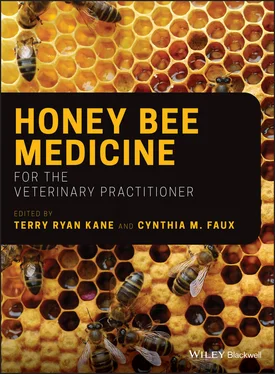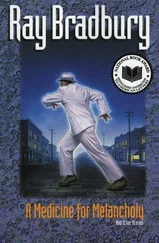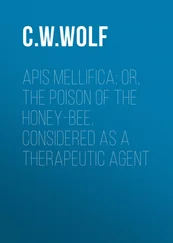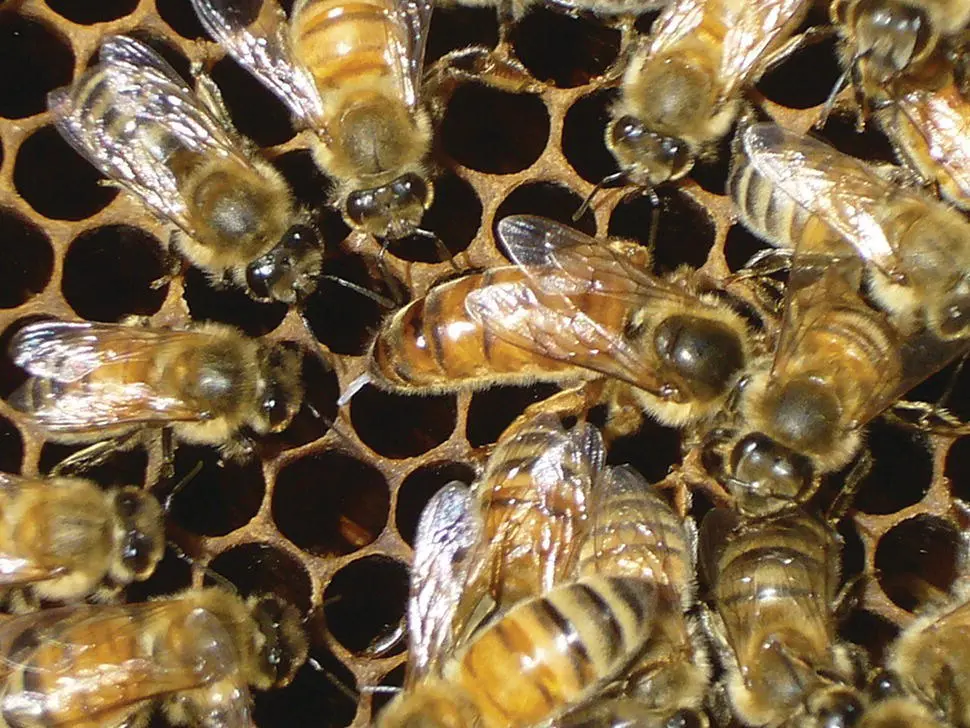
Figure 5.3 A well‐fed queen is an egg‐laying machine, capable of producing an egg per minute, 24 hours a day (and up to double that rate in bursts). If she cannot locate an empty cell, she will just drop the egg (as this queen is doing), which will be consumed and recycled by a nurse bee.
Similar to workers and drones, upon emergence, a young queen may consume nectar or honey, but unlike them, she does not consume pollen as a protein source, 2 instead depending upon receiving a diet of jelly begged from nurse bees for her entire life. A queen can lay more than her body weight in eggs in a day, and thus requires an exceptionally nutritious diet. The jelly diet is so perfect that a queen's feces look like droplets of water. Due to this diet, queens carry a different endosymbiotic microbial community structure than do workers (Anderson et al. 2018), and typically live to a much longer age ( Figure 5.3).
A queen is not really a queen until she has successfully mated, and is barely recognized by the workers until then. A few to several days after emergence, a “virgin queen” ( Figure 5.4) flies out to mate with about 15 drones (often more) in what is known as a “drone congregation area,” during a one to two day period when the temperature is above 70 °F ( Figure 5.5). She returns to the hive exhibiting the torn endophallus of the last drone with which she mated, which must be removed by the workers ( Figure 5.6). The workers then begin paying attention to her ( Figure 5.2) (Richard et al. 2007), and she shifts her pheromonal output to signal that she is adequately mated. A few days later (typically 10–14 days after emergence, weather permitting), the queen begins to lay eggs ( Figure 5.7).
Practical application: It's important to know that if a virgin is constrained from mating by weather, that the chance of her ever successfully being mated decreases greatly after three weeks.

Figure 5.4 To the untrained eye, virgin queens are difficult to spot. Look for her longer legs, slightly more angular “hips,” and rapid movement atypical of the rest of the bees on the comb.
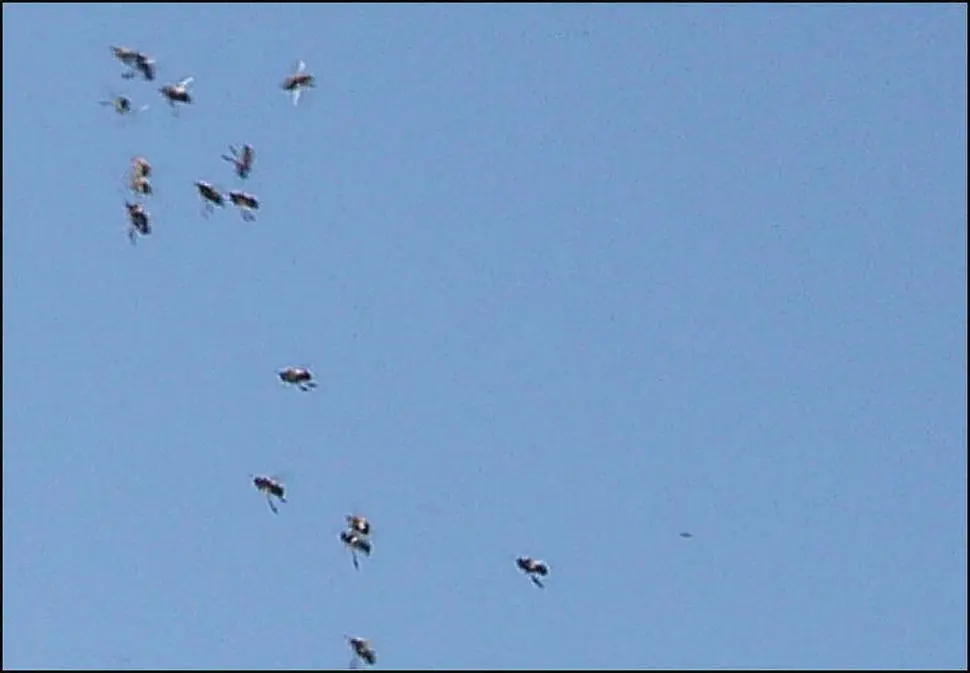
Figure 5.5 The leading edge of a “drone comet” chasing a “virgin” queen. At the top left you can see a drone starting to mount the queen. Slightly lower is what appears to be the previously‐successful drone paralyzed and falling to his death after his explosive ejaculation.
After mating, the queen homogenizes the received semen, and discards roughly 95% of it, holding the remaining mixed spermatazoa in a clear sac called the spermatheca, in which the spermatozoa can remain viable for years.
Practical application: Temperature extremes, or certain insecticides and beekeeper‐applied miticides, may diminish the viability of the spermatozoa, causing early failure of the queen. The seminal fluid received may confer some immunity to pathogens (as well as pathogen exposure), and affect the spermatozoa of other drones.
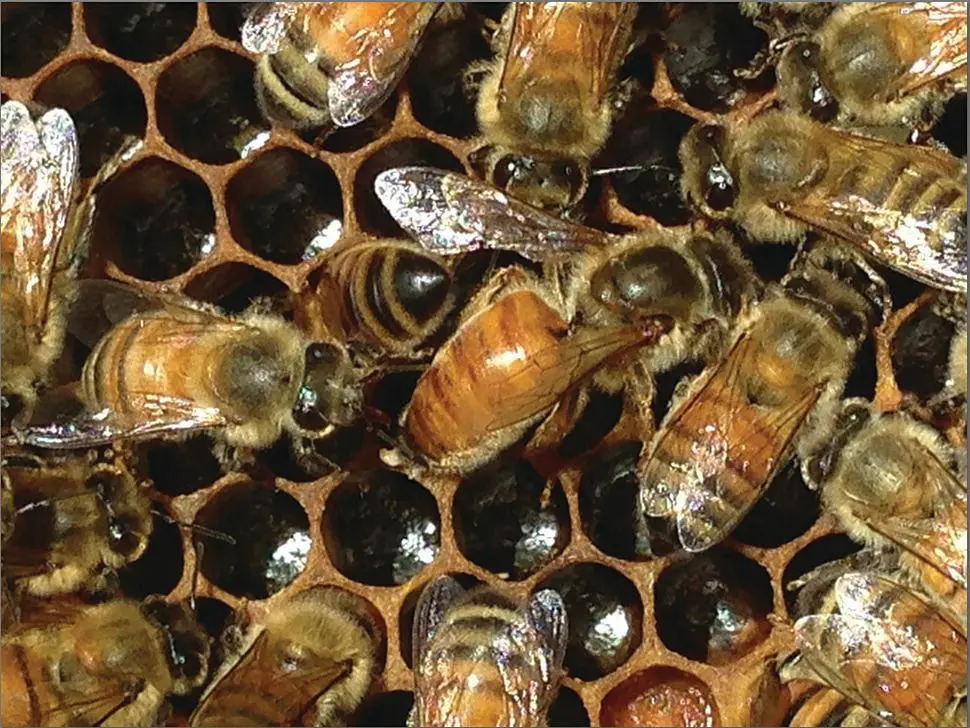
Figure 5.6 A freshly‐returned no‐longer‐a‐virgin exhibiting “mating sign” – the torn endophallus of the last drone to successfully mate with her. This will soon be removed by the workers.
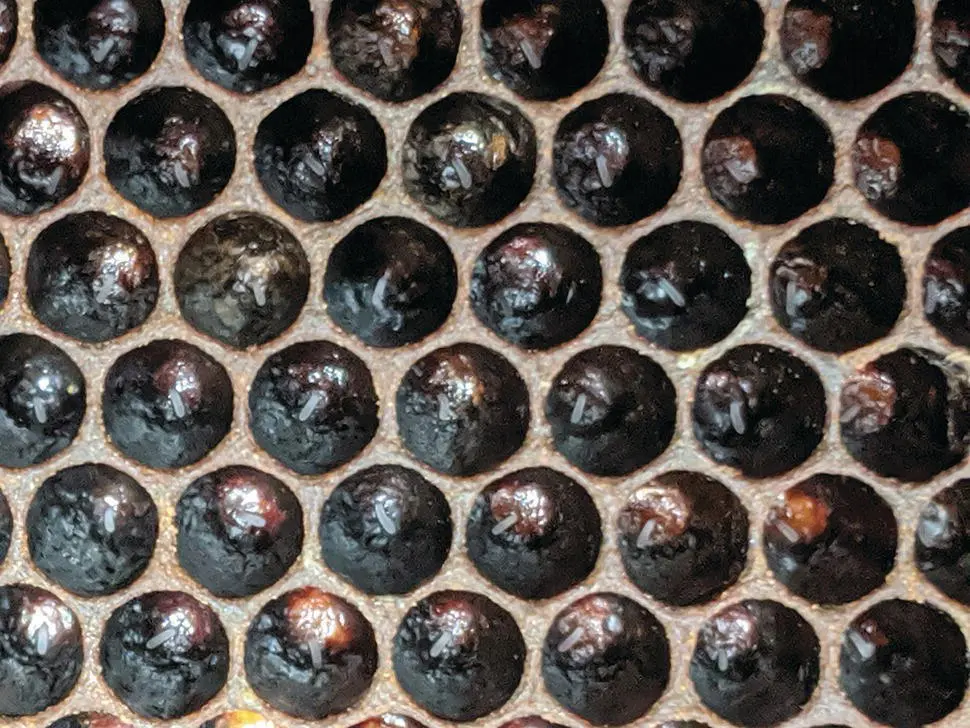
Figure 5.7 Typically 10–14 days after emergence (dependent upon weather), a queen will be mated and commence laying the first of the half a million eggs that she may produce over her lifetime. Each cell in the above photo contains a single egg.
Practical application: Many novice beekeepers, resistant to put on their reading glasses, are unable to identify eggs in the combs. To see eggs, face toward your shadow, which will allow sunlight to come from behind you to illuminate the bottoms of the cells. Don' t confuse white reflections with eggs – eggs look like white grains of rice standing on end.
Be aware that an egg may carry virions on its shell (notably Deformed Wing Virus), but inside carry proteins that confer transgenerational immune priming to her offspring (Salmela et al. 2015).
A queen's performance is mainly measured by how eggs she lays each day.
Practical application: A queen's potential performance is often throttled by the number of prepared, thermoregulated, empty brood cells available in the hive. A good queen cannot exhibit her full laying capacity until the cluster covers at least 10 deep combs, and even then she would be limited if there were appreciable amounts of honey or beebread in those combs. The exceptional queen can nearly completely fill 10 deep combs with brood.
Young queens are typically more “exuberant” in their egg‐laying than are older queens (newly‐mated queens may even lay multiple eggs in a cell if there is not adequate room in the cluster). Young queens as a rule outperform older queens, although many queens are highly productive in their second year (which then often leads to swarming).
The performance of a queen is based upon a few main factors (listed in approximate order of importance):
1 How well she was fed and cared for during her larval development, which determines her egg‐laying capacity, 3
2 How well she was mated – the number of viable spermatozoa in her spermatheca, and
3 Environmental factors, such as chilling and heating during shipment, or pathogen or pesticide exposure in the colony.
A queen's potential performance is largely fixed by how lavishly she is fed jelly during the approximately four days between the emergence of her larva from its egg until her cell is sealed (she continues to feed and grow after sealing). And then she must get properly mated.
Queen Performance vs. Colony Performance
The queen's contributions to colony “colony performance” are:
1 The number of eggs that she produces,
2 Her genetics, which then supply half the genetics to each of her daughters – the workers,
3 The genetics of the guys she mated with – the other half of the genetic equation, and
4 Some passing on of transgenerational epigenetic immunity.
After that, it's up to her offspring. Colony‐level performance is mostly the result of how well the genetically‐diverse patrilines of workers work as a “team.”
Practical application: In general, a well‐reared, well‐mated queen of average genetics will outperform a poorly reared, poorly mated queen of the best genetics. After that, it's largely a matter of chance of how the patrilines of daughters happen to function together as a “team” (Figure 5.8 ), “performance” being more the result of the workers than the queen.
Читать дальше
